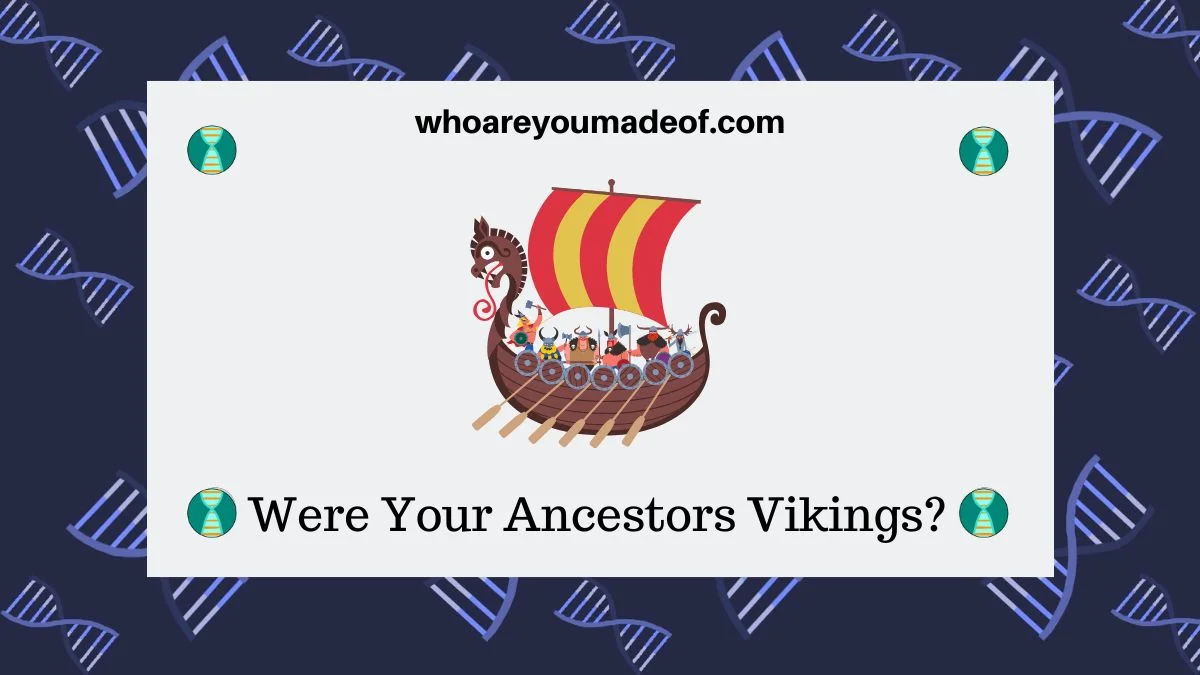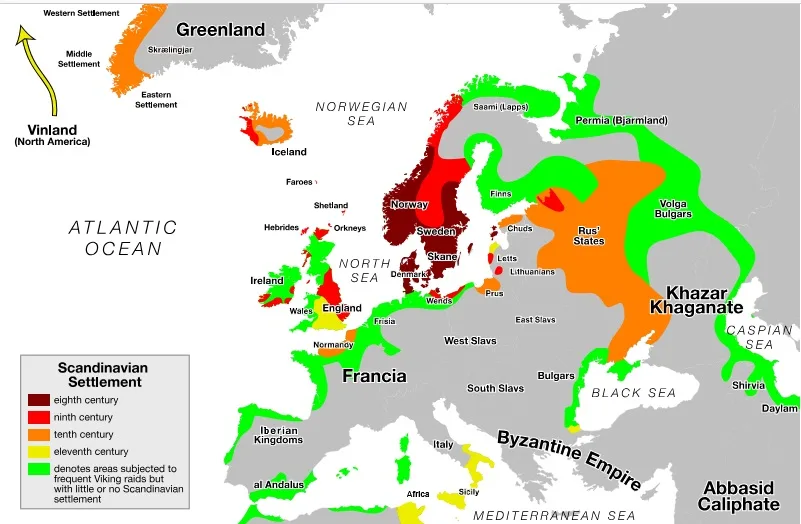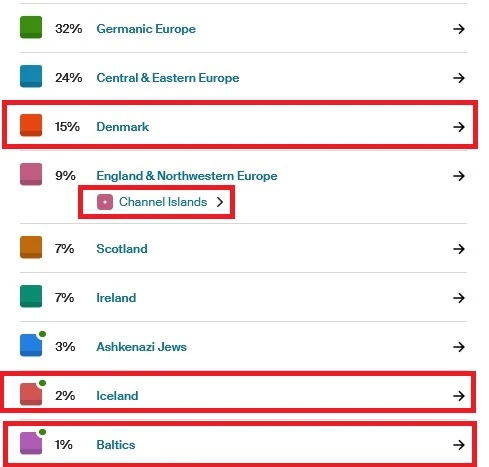Do you wonder whether your ancestors were Vikings? In this post, learn how you can find out if you likely have Viking ancestry, and much more.

In the past few decades, we have seen modern culture develop a fascination with all things Viking. This fascination has been encouraged by artists, books, television shows and movies, as well as DNA testing.
The Vikings were the inhabitants of Scandinavia, now known as Denmark, Finland, and Norway, during the Middle Ages. As they explored, settled, and plundered European coastal areas, they became known for their sea-faring abilities, as well as their fierce warriors.
They left a lasting mark on many of the cultures that they encountered. For example, the English language has many words that are of Old Norse origin, which was the language spoken in Scandinavia during the Middle Ages.
These words include egg, heathen, law, sale, saga, ransack, knife, axe, and yule - among many, many others.
Other countries, such as Iceland, have oral storytelling traditions that extend centuries back in time to the Vikings.
To know whether you and your family are likely to have Viking ancestry, we need to explore the culture and history of the Vikings, evidence obtained from your family tree and, if possible, DNA results.
Do you have known ancestry from places the Vikings visited?
One way to know whether you are likely to have Viking ancestors is by examining the places where your known ancestors came from. If you have ancestors who are from areas heavily impacted by Viking exploration, then your ancestors may have been descended from Vikings.
If you don't know where all of your ancestors lived, you can take a DNA test from a reputable company, such as Ancestry, 23andMe, or MyHeritage, to see where they may have lived in the past several hundred years or so.
Below, see the parts of the world that were touched by Vikings. The Vikings likely left their genetic influence anywhere that they visited.
Areas contacted by the Vikings
Between about 700-1000 CE, people from this region traveled on ships to areas along the coast of Europe, North America and Africa. Almost anywhere along the entire coast of Europe and Northern Africa saw Viking raids, including coastal areas of the Mediterranean Sea.
The Vikings were also able to reach Iceland, Greenland, and even parts of what is now Canada. Archeologists know this because there is evidence of Scandinavian settlements, possibly referred to as "Vinland" by the Norse, in the Canadian province of Newfoundland.
In addition to coastal areas, the Vikings were able to reach inland areas via various long rivers and inland seas. This allowed Viking influence to spread throughout Russia, and even into parts of Asia and the Middle East via the Caspian Sea.
A good example of Viking inland access was the route that they used to access interior parts of Russia via the Volga River. The Gulf of Finland located in the Baltic Sea allows access to the Neva River in St. Petersburg, through which the Vikings could access Lake Ladoga.
From Lake Ladoga, ships could sail to the Volkhov River, which allowed direct access to the Volga River. The Volga River is the longest river in Europe, flowing more than 2,000 miles into the Caspian Sea, allowing access the entire interior of Russia.
This route became known as the Volga Trade Route, which was used for centuries. The Vikings used this trade route to transport coins, precious minerals, products, such as furs, and even Eastern European slaves.
Where did the Vikings settle?
Did you know that the Vikings created permanent settlements in many of the places to which they traveled? The Vikings essentially migrated to many of the areas that their warriors raided.
They brought their families with them and became part of the local community. Over time, the Vikings themselves were forgotten, but their genetic and cultural influence remained.
The map below shows the progression of Viking settlements throughout the centuries. The areas closest to Scandinavia were settled the earliest.
If you have ancestors from any of the areas that experienced Viking settlements, there is a strong probability that you have Viking ancestors. This is because the Viking settlers integrated themselves into the local communities and their descendants stayed in those areas.

Map credit: Max Naylor
The green color on the map denotes places where the Vikings did not establish permanent settlements. These areas include most of Northern Africa, the Iberian Peninsula, most of the the coast of the Black and Caspian Seas, as well as a large portion of the Volga Trade Route.
One reason that the Vikings did not establish settlements everywhere they raided may be due to other powerful political and military influences in the region. For example, the Byzantine Empire was a very powerful empire during the Viking Ages, and their military might was likely a limiting force to Viking expansion.
Genealogy can help identify likely source of Viking ancestry
If you don't already know where your ancestors came from, you can learn about your family tree in order to determine whether you have likely Viking roots. The first step is to build a small family tree.
I prefer to build my family trees on Ancestry because it doesn't cost anything to have my tree stored on that site. While you would need a subscription to access genealogy records on the site, it is free to have your family tree there.
How to build your Viking family tree
To build your family tree, you will need the names of your parents and grandparents. With that information, you can use sites like Family Search or Ancestry to find documents that can help you figure out who your great-grandparents and great-great grandparents were.
Documents that can help you trace your ancestors include:
- vital records, such as birth, death, and marriage certificates
- census records
- church or other religious records
As you go further back in your tree, there are some clues that you look for that might indicate Viking ancestry. For example, if you discover that one of your ancestors was from a Scandinavia country, then you know that you likely have Viking ancestry.
How can a single Scandinavian ancestor mean you have Viking ancestors?
While it might seem strange to be sure that only one ancestor from a Scandinavian country likely means Viking ancestry, it's probably true. A single ancestor from say, Sweden, likely has hundreds of thousands of ancestors.
Due to pedigree collapse, you could even assume that your Swedish ancestor is probably descended from anyone who lived in Sweden 1,000 years ago who has living descendants. Since Sweden was filled with Vikings 1,000 years ago, if you have a single known Swedish ancestor, you likely have many ancestors who were Vikings.
Look for ancestors from Viking-heavy regions
If you can't determine a direct link between your known ancestors and a Scandinavian ancestor, you might be able to find ancestors who were from areas heavily settled by the Vikings.
A great example of this is the Normandy region of France. The Vikings settled in this region around 900 and intermingled with the local population.
The Norse influence on the Norman region in France was so great that it remains today. More than 100,000 people in the Channel Islands speak a dialect of "Norman" (which comes from the word Norsemen), or Norman French, a version of French influenced by Old Norse, the language of the Vikings.
Other areas that saw extensive Viking settlements include England, northern Scotland (especially the northern islands), southern Ireland, Greenland, Iceland, as well as parts of Russia and Eastern Europe.
After you build your family tree back as far as you can, research the areas where your ancestors came from to see if you can find a Viking connection.
Look for genetic connections to Viking regions
If you have already taken a DNA test, or want to take one, you can look at your results to see if you can find genetic evidence of your ancestral connection to the Vikings. There are three types of DNA results that can help you learn about your potential Viking ancestry.
Viking autosomal DNA
Autosomal DNA is the DNA that we inherit in equal amounts from both of our parents contained on our 22 numbered chromosomes. Companies like Ancestry, 23andMe, MyHeritage, and Family Tree DNA offer good-quality autosomal DNA testing.
Autosomal DNA results typically have at least two elements. You will receive a list of DNA matches along with an ancestral origins or ethnicity estimate.
The ethnicity estimate is what we will generally use to look for autosomal DNA evidence that our ancestors were likely Viking. If you have regions on your ethnicity estimate that correspond to places where Vikings lived or heavily settled, then you probably have Viking ancestry.
The image below is from my own personal DNA results. I have highlighted the regions that could potentially be sources of Viking ancestry for myself. They include Denmark, the Channel Islands, Iceland, and the Baltic region.

I could also have Viking ancestry from England, Scotland and Ireland, but I chose to only highlight the most obvious connections.
In order to learn more about my possible Viking ancestry, I will need to build back my family tree even further in order to identify the ancestors who came from these locations.
Unfortunately, very few people have a family tree that will go back more than 1,000 years to the Viking Age. Only royalty, with few exceptions, have family trees this accurate.
Conclusion
While it is likely impossible to "prove" your connection to the Vikings or any specific Viking person, it is certainly fun to work on your family tree to increase the evidence that you do come from a place that has Viking history.
You will be sure to learn more about your ancestors, no matter where they came from, which will help you more fully understand your family history.
If you have any questions about something that you read in this post, or if you would like to share something that you have discovered about your own likely connection to the Vikings, I would love to hear from you in the discussion below.
Thanks for reading today!

Linda Ford
Friday 29th of August 2025
Considering my direct Grandparent ancestors and my blood line of 23.3% English,18.7% Danish, 18.2% Dutch and the locations of where my past ancestors lived that I have traced, covers pretty much every area on your map example. I would say there is little doubt my people were Vikings. This is still a work in progress but in this day and age it sure is much easier to get the information and with all of the new discoveries it just makes it easier. Thank you I greatly enjoy your articles.
Brian Devitt
Sunday 24th of August 2025
I have traced my Ancestry back to the 7th-century Vikings, Olaf "The Wood Cutter" Injaldsson, circa 684. This is via Rollo the Viking of Normandy fame (870-937) and subsequently William the Conqueror.